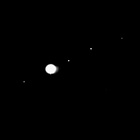
- Object Type: Moon
- Distance (closest to Earth): 600 million km (33 light minutes)
- Galileo's observations of Jupiter led to the discovery of four large satellites – called the Galilean Moons. Each Galilean Moon is a unique world: Io is engulfed in lava and volcanoes, Callisto has the oldest and most cratered surface in the solar system, Ganymede is bigger than the planet Mercury, and Europa may have a vast underground ocean. Using your OWN observations of Jupiter, create a movie to watch the motions of the Galilean moons, and compare your observations to those of Galileo. Explore more images of Jupiter's moons in NASA's Photojournal. - Mikroobserwatorium, jak ostatnio;)
Ciągle się bawiąc portalem Eyes on the Solar System, podpiąłem pod powyższy tekst widok Galileo nad Europą:
Dane, dotyczące daty kiedy nastąpiło spotkanie sondy z lodowym księżycem można znaleźć między innymi na Galileo legacy site. Tu pozwoliłem sobie jeszcze wkleić film, powiązany z miniaturką widoczną powyżej w sekcji multimedia:
Urzekła mnie jeszcze grafika wyszperana w poświęconej misji Galileo sekcji Artwork:
 Przedstawia ona spotkanie Galileo a Amaltheą, które miało miejsce w listopadzie 2002. Czy Eyes on the Solar System potrafi wygenerować podobny widok sprawdzę może innym razem. Tymczasem tak prezentuje się Amalthea w Celestii:
Przedstawia ona spotkanie Galileo a Amaltheą, które miało miejsce w listopadzie 2002. Czy Eyes on the Solar System potrafi wygenerować podobny widok sprawdzę może innym razem. Tymczasem tak prezentuje się Amalthea w Celestii:
Do wygenerowania grafiki użyłem Celestii Gregoria. Jak sprawdza się w wersji "bez upiększeń" można sprawdzić klikając tu.


Brak komentarzy:
Prześlij komentarz